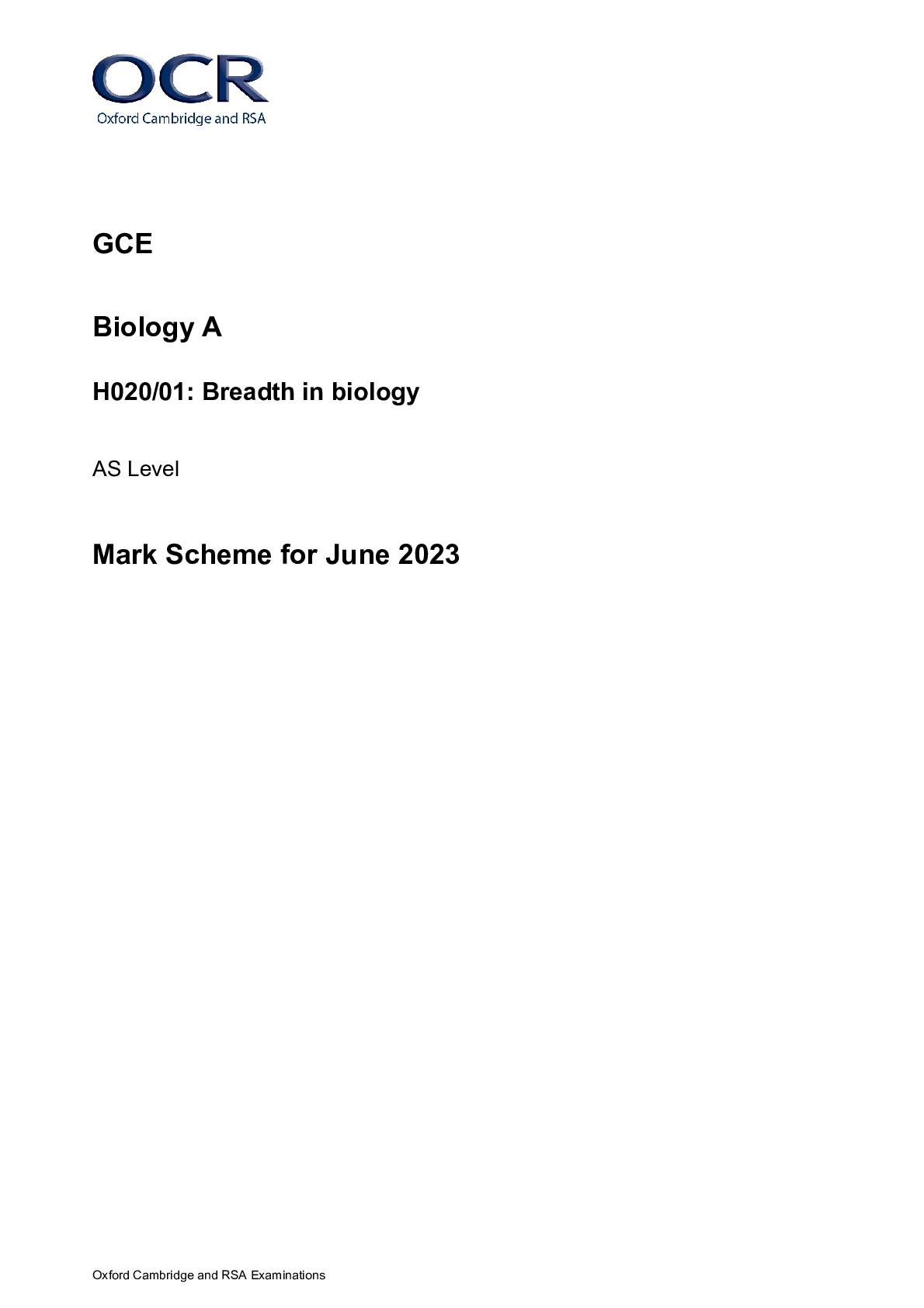Physics > MARK SCHEMES > GCE Physics B H557/03: Practical skills in physics Advanced GCE Mark Scheme for Autumn 2021 (All)
GCE Physics B H557/03: Practical skills in physics Advanced GCE Mark Scheme for Autumn 2021
Document Content and Description Below
GCE Physics B H557/03: Practical skills in physics Advanced GCE Mark Scheme for Autumn 2021 Oxford Cambridge and RSA Examinations GCE Physics B H557/03: Practical skills in physics Advanced ... GCE Mark Scheme for Autumn 2021Oxford Cambridge and RSA Examinations OCR (Oxford Cambridge and RSA) is a leading UK awarding body, providing a wide range of qualifications to meet the needs of candidates of all ages and abilities. OCR qualifications include AS/A Levels, Diplomas, GCSEs, Cambridge Nationals, Cambridge Technicals, Functional Skills, Key Skills, Entry Level qualifications, NVQs and vocational qualifications in areas such as IT, business, languages, teaching/training, administration and secretarial skills. It is also responsible for developing new specifications to meet national requirements and the needs of students and teachers. OCR is a not-for-profit organisation; any surplus made is invested back into the establishment to help towards the development of qualifications and support, which keep pace with the changing needs of today’s society. This mark scheme is published as an aid to teachers and students, to indicate the requirements of the examination. It shows the basis on which marks were awarded by examiners. It does not indicate the details of the discussions which took place at an examiners’ meeting before marking commenced. All examiners are instructed that alternative correct answers and unexpected approaches in candidates’ scripts must be given marks that fairly reflect the relevant knowledge and skills demonstrated. Mark schemes should be read in conjunction with the published question papers and the report on the examination. © OCR 2021H557/03 Mark Scheme October 2021 Page 2 1. Annotations available in RM Assessor Annotation Meaning Benefit of doubt given Contradiction Incorrect response Error carried forward Level 1 Level 2 Level 3 Transcription error Benefit of doubt not given Power of 10 error Omission mark Error in number of significant figures Correct response Wrong physics or equationH557/03 Mark Scheme October 2021 Page 3 2. Abbreviations, annotations and conventions used in the detailed Mark Scheme (to include abbreviations and subject-specific conventions). Annotation Meaning / alternative and acceptable answers for the same marking point reject Answers which are not worthy of credit not Answers which are not worthy of credit Ignore Statements which are irrelevant Allow Answers that can be accepted ( ) Words which are not essential to gain credit __ Underlined words must be present in answer to score a mark ECF Error carried forward AW Alternative wording ORA Or reverse argumentH557/03 Mark Scheme October 2021 Page 4 Question Solution Marks Guidance 1 a i One mark for each column. 1.01 1.03 1.11 1.22 2 Accept t2 (any combination) 1.02 1.23 ii Both points (their values) plotted correctly to within half a small square. Horizontal error bars on every plot EITHER Length of error bars all median value of 0.03 (¾ small square) – accept ½ to 1 small square either side. OR Length of 6 error bars correct – see table in guidance (to within ½ small square) 3 height spread small squares 2.00 0.02 up to 1 3.00 0.01 up to ½ 4.00 0.03 ½ to 1 5.00 0.03 ½ to 1 6.00 0.06 1 to 2 7.00 0.06 1 to 2 8.00 0.04 ½ to 1½ Ignore any vertical error bars. iii Acceptable straight line of best fit drawn. Gradient calculated correctly. 2 Acceptable range: steepest from (0.24, 1.0) to (1.8, 8.8) least steep from (0.2, 1.0) to (1.8, 8.6) gradient should be in range 4.75 to 5.0 for an acceptable line. Only answer of 5 (1sf) if calculated value equals 5.0. Watch out for incorrect gradient calculation giving value in range. ALLOW ecf from candidate’s line if correct working shown.H557/03 Mark Scheme October 2021 Page 5 iv Acceleration of free fall = 2 x value obtained for gradient in part (iii). EITHER: Worst fit line drawn on graph gradient calculated correctly absolute uncertainty in g within range 0.3 to 0.6 (with correct working) OR: Calculation of approx uncertainty using � = 2� �2 Eg: relative uncertainty of h = 0.02 ÷ 2 = 1% and relative uncertainty of t = 0.015 ÷ 0.66 = 2%. Relative uncertainty in g is 1% + 2 × 2% = 5% Absolute uncertainty in g within range 0.3 to 0.7 (with correct working) 4 s = ut + ½gt2 and u = 0, so gradient = ½g. Value written on the answer line should be twice the value calculate for gradient. Steepest or shallowest line drawn through error bars (if drawn). ALLOW ecf for their error bars. Using median values: relative uncertainty of h = 0.02 ÷ 5 = 0.4% and relative uncertainty of t = 0.02 ÷ 1.01 ≈ 2%. Relative uncertainty in g is 0.4% + 2 × 2% ≈ 4% If candidate has given gradient value = g, only a max 2 marks can be awarded. b i Length of card only. 1 DO NOT ALLOW a list of examples.H557/03 Mark Scheme October 2021 Page 6 ii First mark for identifying a source of error. Second mark for discussion/comparison of effect of that error. Third mark for a second pair of error and comparison. Any of source/effect pairs: • Duration of drop • Light gate method uses shorter drop so a greater relative/percentage error in time measurement ora • Relevant length measurement • Length of card measured in light gate method is smaller then drop height measured for G-ball so greater relative/percentage error ora. • Problem with card falling between light gates • length of card passing through light gates inaccurate. • Air resistance • If air resistance present then g will not be a constant, or some sensible comparison of air resistance on both experiments. • Precision of timer • Both methods using electronic timers so likely to have similar (absolute) uncertainties. 3 IGNORE reference to distance between light gates for first mark. DO NOT ALLOW explicit reference to measuring height of drop in light gate method for the explanation mark. QUESTION TOTAL 15H557/03 Mark Scheme October 2021 Page 7 Question Solution Marks Guidance 2 a Measure across a number of fringes AND find mean spacing (divide by the number of fringe widths); Using a travelling microscope/ruler 2 Accept Vernier callipers b i � = � �⁄�; λ = (8.5 × 10-5) (1.02 × 10-2) ÷ 1.5 λ = 5.8 × 10-7 m. 3 Any subject. Accept � = ��⁄� ALLOW use of �� = ����� with n = 1 ���� = 1.02 ×10−2 1.5 = 6.8 × 10−3. � = 0.39° POT error will lose one mark. b ii Absolute uncertainty in D = ± 1 × 10-2 m EITHER: Percentage uncertainty in λ found by adding their correctly calculated percentage uncertainties eg = 2% + 10% + (.01 ÷ 1.5)*100 = 12.7% or 13% or 12% Absolute uncertainty in λ = 7(.4) × 10-8 m OR State 10% most significant uncertainty and ignore the other two uncertainties. Absolute uncertainty in λ = 5.8 × 10-8 m OR: Max value of λ = (max value of a × max value of x) ÷ (min value of D), or min value of λ = (min value of a × min value of x) ÷ (max value of D) Absolute uncertainty in λ = max value of λ – 5.78 × 10-7, or Absolute uncertainty in λ = 5.78 × 10-7 – min value of λ, or Absolute uncertainty in λ = ½(max value of λ – min value of λ) 1 2 This could be implied/seen in working. ALLOW ecf for incorrect value of λ from (b)(i) ALLOW ecf for incorrect abs uncert in D provided it is between 0 (ignored) and 5 cm. ALLOW 13% to give absolute uncertainty = 8 × 10-8 m If uncertainty in D is ignored/omitted without explanation this final mark can be awarded, for method.H557/03 Mark Scheme October 2021 Page 8 b iii Fringes will be more widely spaced so relative uncertainty in x is less. ANY 2 of: (Red light will have wider spacing of fringes) because (average) wavelength is longer. Relative uncertainty in D and a remain the same. Fringes will be more clearly defined because only one wavelength/frequency or monochromatic ora. Fringes will be brighter/easier to see because laser light is more intense 3 Question total 13H557/03 Mark Scheme October 2021 Page 9 Question Solution Marks Guidance 3 a i l/T or T/l should be constant A set (at least 3) of correct calculations to show that. OR ΔT for each Δl should be constant A set (at least 3) of suitable calculations to show that. OR l/T should be constant Find one value for l/T and then use it to predict values for T for at (east 2) other values of l (or vice versa). 2 length period l/T T/l ΔT 28.0 0.734 38.1 0.0262 26.0 0.677 38.4 0.0260 0.057 24.0 0.623 38.5 0.0260 0.054 22.0 0.569 38.7 0.0259 0.054 20.0 0.511 39.1 0.0256 0.058 Ignore POT as long as consistent. Calculated values should be to at least 2sf If no (or insufficient) calculations, then one mark can be awarded for describing a valid test to carry out. ALLOW one mark max for description of graphical method if straight line through the origin is mentioned. a ii 1 ÷ 0.623 = 1.6(1) Hz 1 b i (Resonance occurs when) driving or forced frequency is equal to the natural frequency; and amplitude will be at a maximum. 2 ALLOW very large amplitude or very large increase in amplitude.H557/03 Mark Scheme October 2021 Page 10 b ii Non-zero amplitude at f = 0 (not maximum) (intercept > 5mm from origin*) Rising to a labelled max amplitude at natural frequency (f = 1.6 Hz); Decreasing towards (not equal to) zero after f0. 3 1.6 Hz frequency amplitudeH557/03 Mark Scheme October 2021 Page 11 b iii Level 3 (5-6 marks) Detailed understanding of damping and resonance. Very clear method and explanation of expected results. There is a well-developed line of reasoning which is clear and logically structured. The information presented is relevant and substantiated. Level 2 (3-4 marks) Clear understanding of how damping affects resonant amplitudes. Clear method and description of expected results. There is a line of reasoning presented with some structure. The information presented is relevant and supported by some evidence. Level 1 (1-2 marks) Limited understanding of how damping relates to resonance. Some description of experimental method and/or expected results. There is an attempt at a logical structure with a line of reasoning. The information is in the most part relevant. 0 marks No response or no response worthy of credit. 6 Indicative scientific points may include: Data collection: • Find or use the natural frequency of the undamped blade • record the amplitude of oscillations for both damped and undamped blades at different driving frequencies. • repeat and determine an average amplitude at a given frequency. • frequency range should be either side of natural frequency. • adjust the frequency in small increments close to the resonant frequency. Expected findings and explanation: • cards cause damping due to air resistance. • damped oscillations will have smaller amplitude at all frequencies. o damping removes energy from the oscillating system. o the larger card causes more damping than the smaller card. o ignore any reference to damped free oscillations. • the amplitude at resonance is only dependent on the amount of damping. • forced oscillations will be out of phase with the driver oscillator. • frequency of resonance decreases with increasing damping. • More highly damped oscillator will have a broader resonance peak ora • damped oscillators have amplitudeof driver at f = 0. • Expected findings could be seen by plotting graphs of amplitude against frequency for the damped blades. Question total 15H557/03 Mark Scheme October 2021 Page 12 Question Solution Marks Guidance 4 a i Alpha line stops at paper Beta line stops at 3mm Al Gamma line continues through 1cm Pb 1 1 mark for ALL three paths drawn correctly. Allow arrows. ii Radiation needs to be detected outside the body so γ emitter is used OR β not suitable. Radiation causes damage/larger dose to patient so β less suitable (more ionising) OR γ more suitable (less ionising). 2 1 mark max. may still be awarded for a correct statement from the marking points if Xenon-135 is chosen If neither isotope is identified, then max 1 mark. Ignore any reference to half-life iii �� 81�� → 8136 ��� + 1 0�(+) + 0 0� 37 e (with or without the bar) 2 1 mark for each. Accept β or β+ NOT e- or β-. iv Rubidium decays to produce Krypton. 1 Mark given for candidates clearly demonstrating they understand the krypton is generated at the point of use from the parent isotope. b i • reduce time using the source; • this reduces total exposure/dose to ionising radiation OR • use tongs to handle source; • increases distance from source OR minimise contamination OR • wear gloves • to minimise contamination OR • point source away from body/use shielding • to reduce dose OR • other valid precaution • associated explanation 2 1 mark given for the precaution, 1 mark for the related explanation. An explanation on its own gains no marks. ii (This records) background radiation This value will be subtracted from measurements taken with the source (to obtain the count rate for the source). 2H557/03 Mark Scheme October 2021 Page 13 c i* Level 3 (5-6 marks) One (or more) full, accurate and clearly explained mathematical test(s) to show it is exponential AND an accurate calculation of the half thickness. There is a well-developed line of reasoning which is clear and logically structured. The information presented is relevant and substantiated. Level 2 (3-4 marks) A correct mathematical test attempted from the data and/or a correct calculation of half-thickness from the graph (multiple readings necessary) with some explanation of mathematical method. There is a line of reasoning presented with some structure. The information presented is relevant and supported by some evidence. Level 1 (1-2 marks) There is a basic description of the pattern shown by the data with an incorrect or partial calculation of either the mathematical test or half thickness. There is an attempt at a logical structure with a line of reasoning. The information is in the most part relevant. 0 marks No response or no response worthy of credit. 6 Indicative scientific points may include: Use of data in table: • Data from table used to find constant reduction factor between successive data points. • Multiple data points tested and shown to have a constant factor. • Natural log values for count rate calculated and the difference between successive values calculated and found to be constant. • Other valid test applied successfully. Use of graph: • count rate decreases with increasing thickness; • Relationship shows an exponential decrease of count rate with increasing thickness; • Data showing count rate halves at regular intervals of shielding thickness. • Thickness found for count rate to drop by same fraction (half-thickness); • Finding gradient of curve at different thicknesses to show that it halves at regular intervals. Calculation of half-thickness value: • Half thickness ≈ 2cm. • Graph used to take measurements of half-thickness. • Multiple measurements taken at different values of count rate. • Average value for half-thickness calculated for precision. • Use �2 �1 = �−�� or ln �2 − ln�1 = � and �0.5 = ln 2 � with data from table. • �2 �1 ≈ 0.72; hence �0.5 = 2.1 cm. • ln �2 − ln �1 ≈ 0.33; hence �0.5 = 2.1 cm.H557/03 Mark Scheme October 2021 Page 14 Example data from table: thickness count rate ratio log values diff 0 1240 7.1229 1 905 0.7298 6.8079 0.3149 2 626 0.6917 6.4394 0.3686 3 465 0.7428 6.1420 0.2973 4 343 0.7376 5.8377 0.3043 5 230 0.6706 5.4381 0.3997 6 172 0.7478 5.1475 0.2906 Mean ratio 0.7201 mean difference 0.3292 Example data from graph: count rate thickness half thickness 1200 0.2 600 2.2 2 1000 0.7 500 2.7 2 800 1.3 400 3.4 2.1 600 2.2 300 4.2 2 400 3.4 200 5.4 2H557/03 Mark Scheme October 2021 Page 15 ii Equation rearranged to give ln � = ln �0 − µ� Gradient calculation using suitable points with dx ≥ 5 cm. Attenuation co-efficient value = +35 Unit m-1 4 ALLOW values in range 34 to 36. ALLOW answers given in cm-1 (in range 0.34 to 0.36). Unit must correspond to POT of value (or calculation). Question Total 20OCR (Oxford Cambridge and RSA Examinations) The Triangle Building Shaftesbury Road Cambridge CB2 8EA [Show More]
Last updated: 3 years ago
Preview 1 out of 17 pages

Buy this document to get the full access instantly
Instant Download Access after purchase
Buy NowInstant download
We Accept:

Reviews( 0 )
$7.50
Can't find what you want? Try our AI powered Search
Document information
Connected school, study & course
About the document
Uploaded On
Oct 07, 2022
Number of pages
17
Written in
All
Additional information
This document has been written for:
Uploaded
Oct 07, 2022
Downloads
0
Views
85





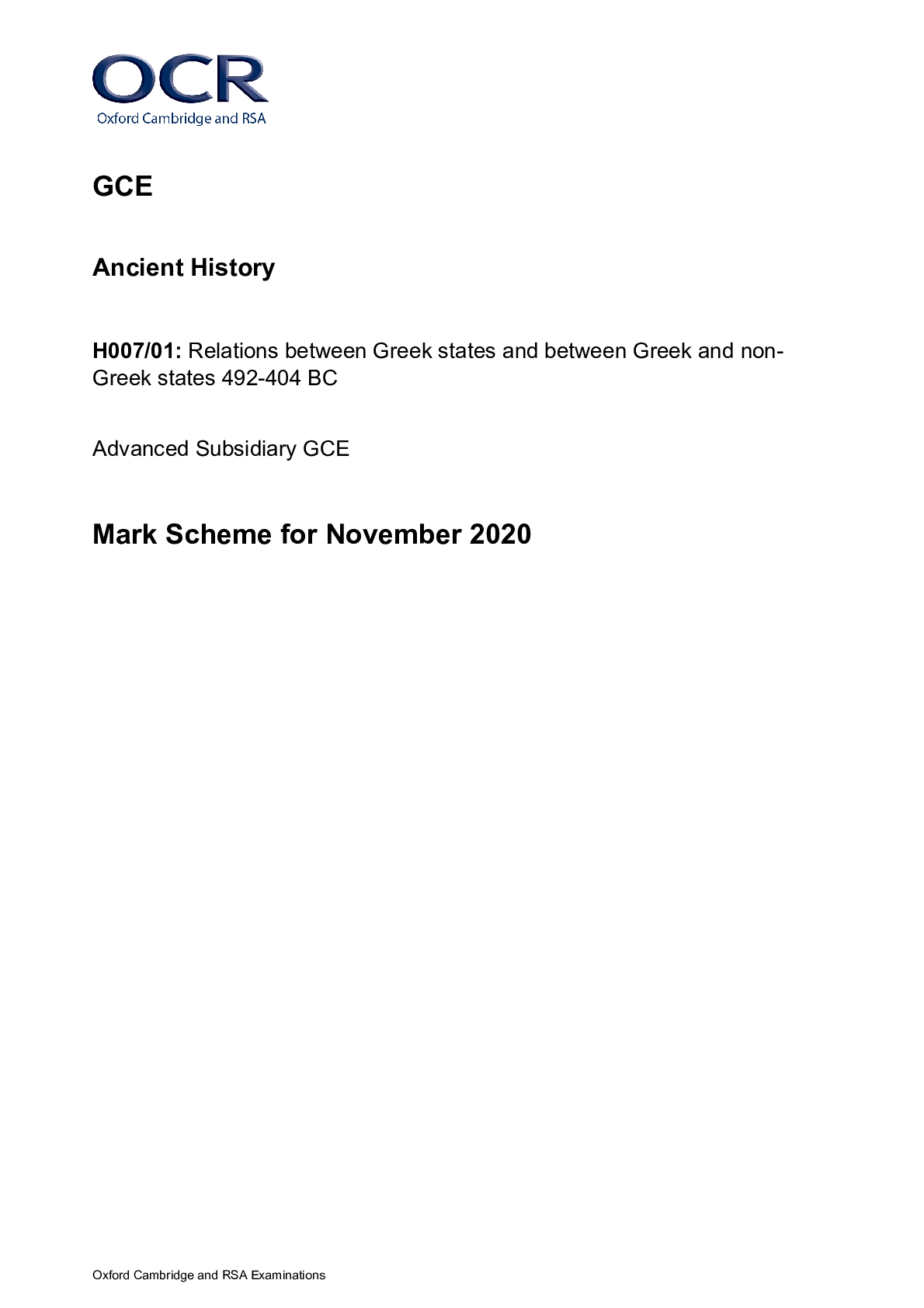




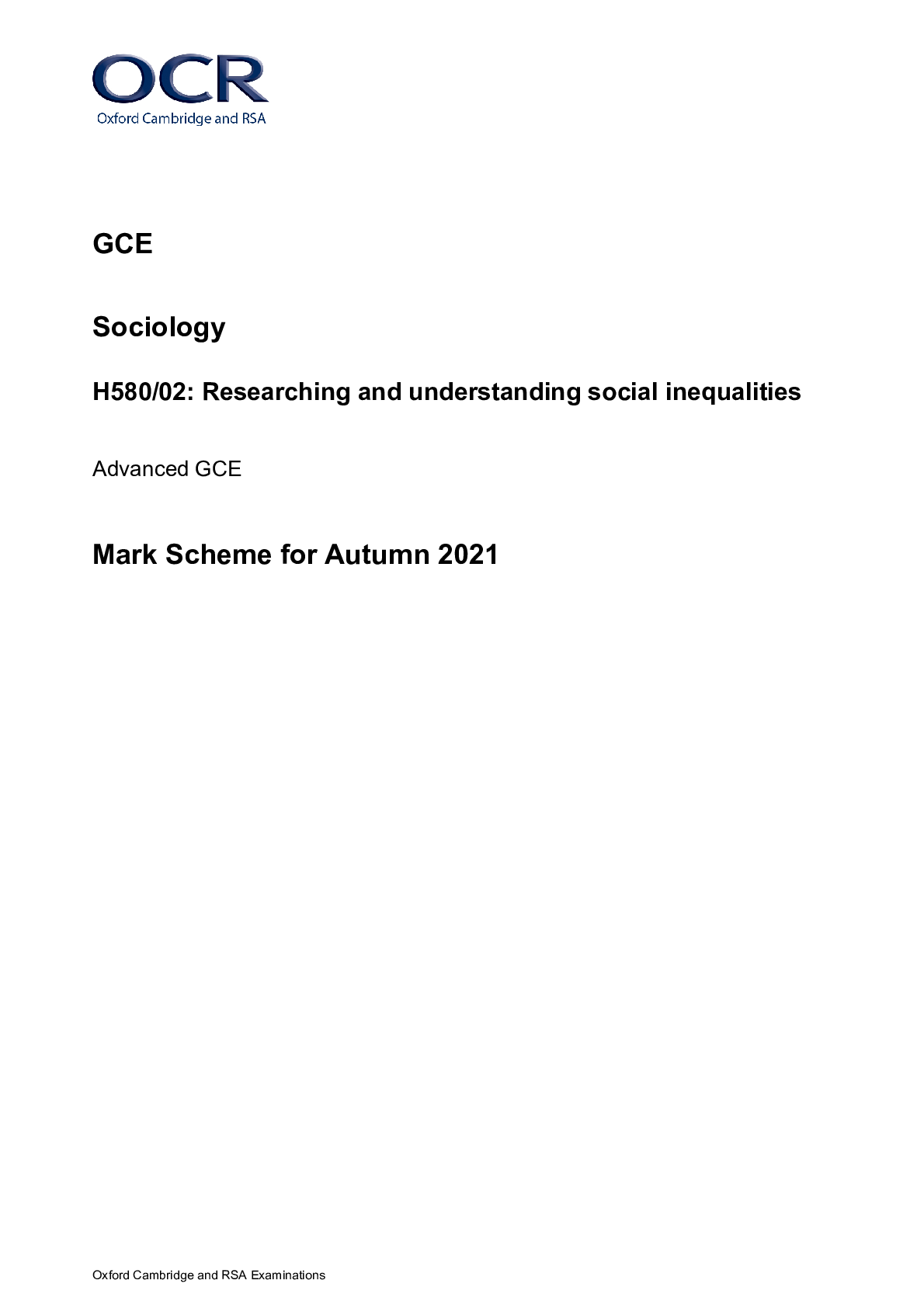



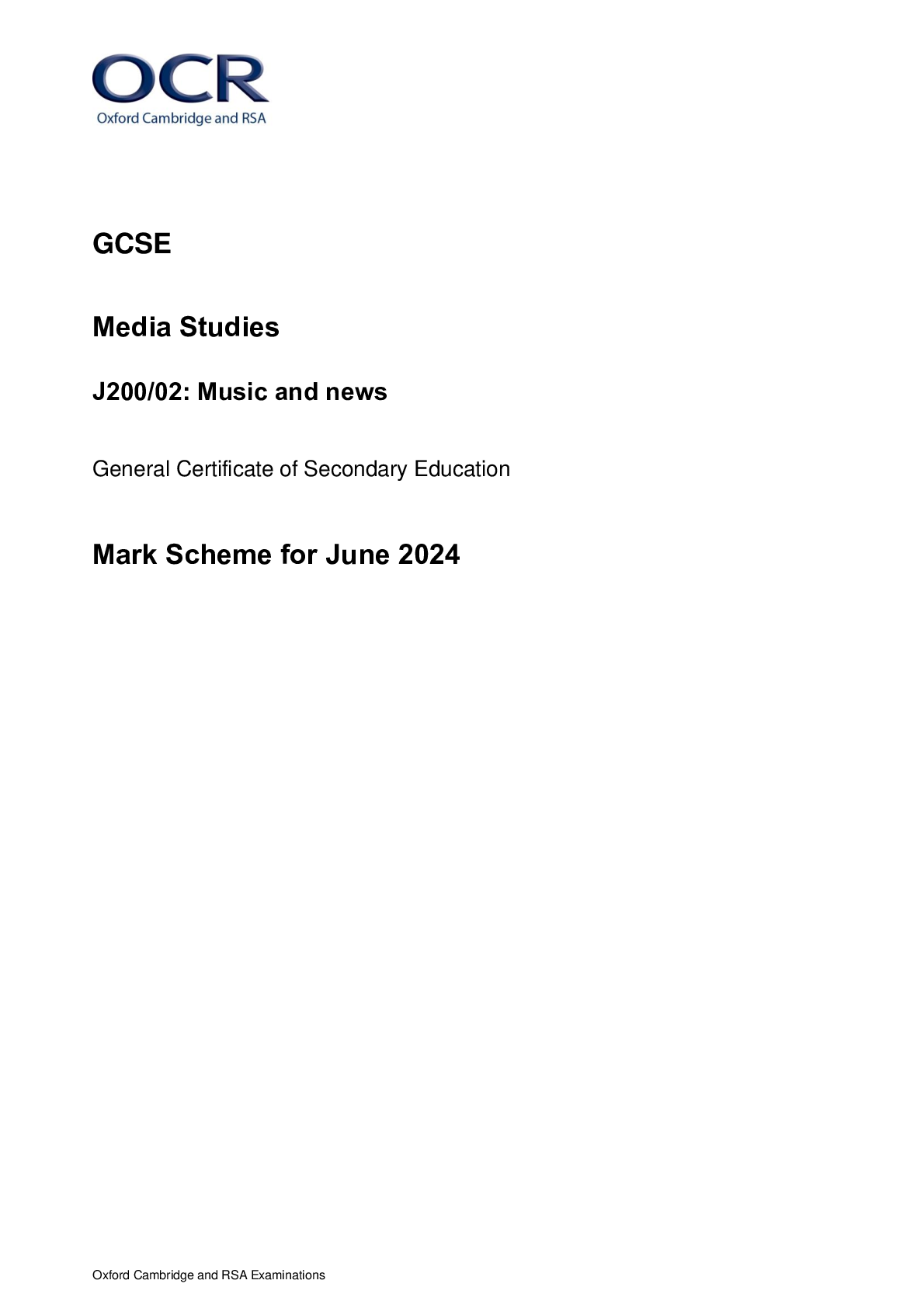

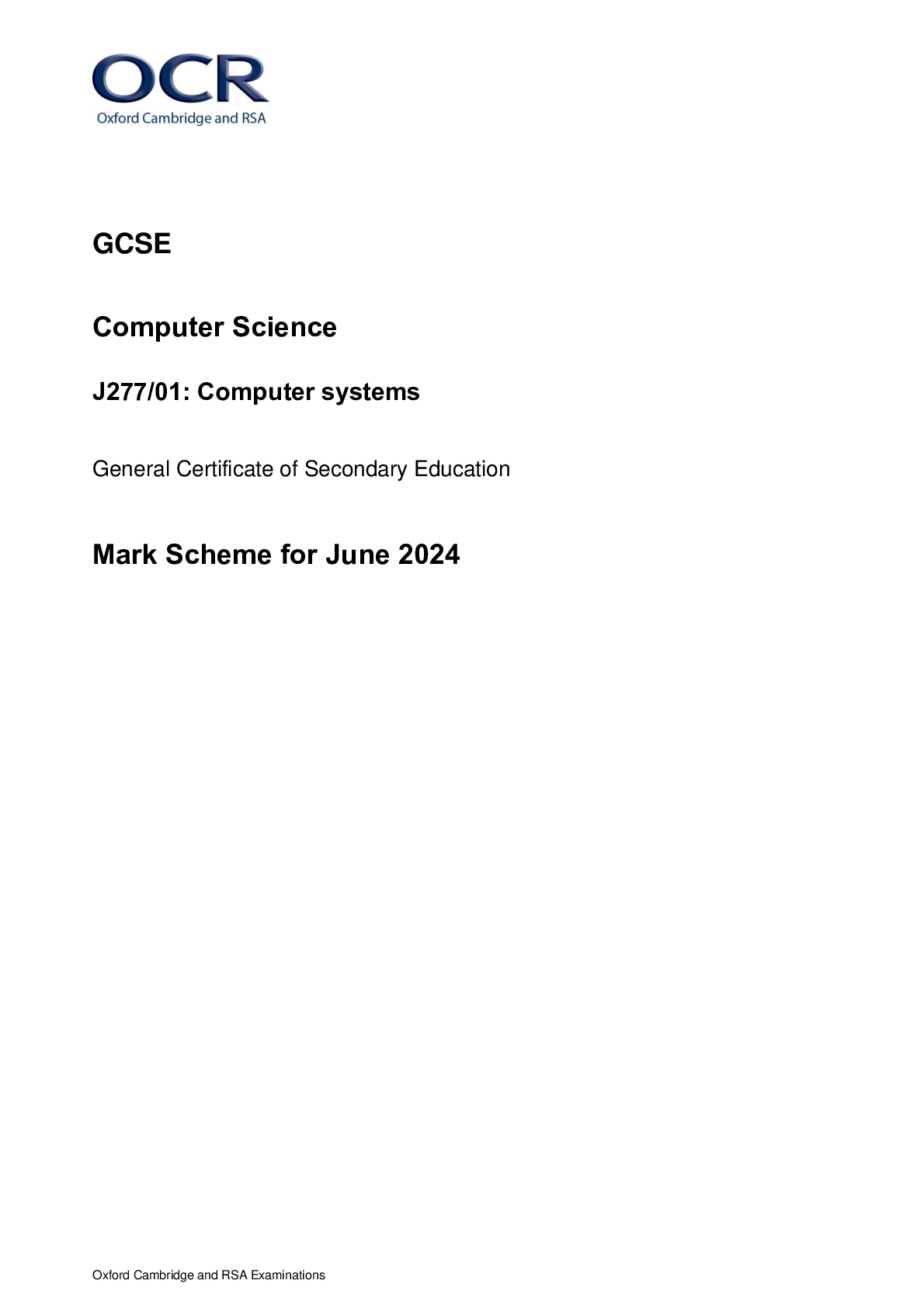
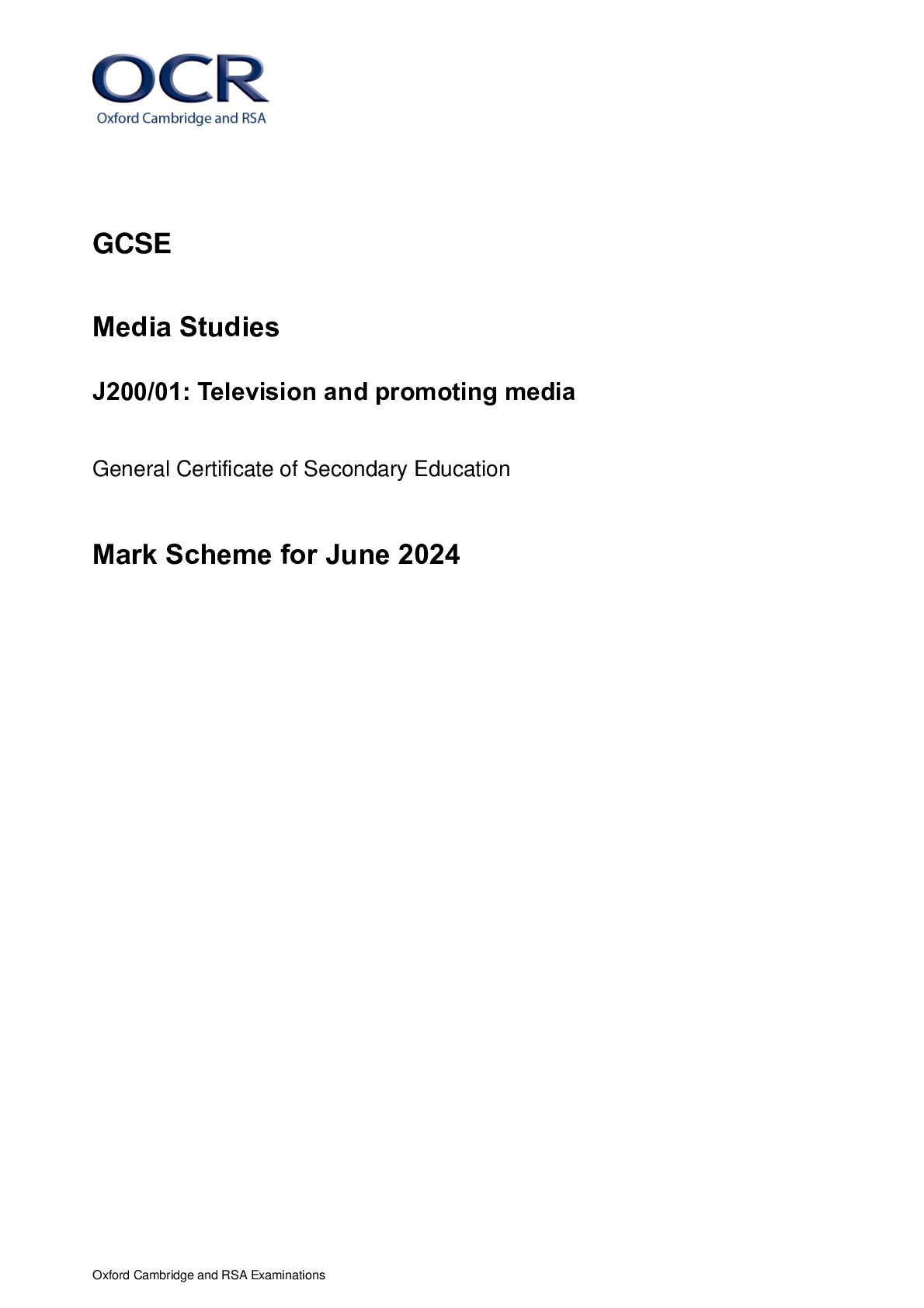
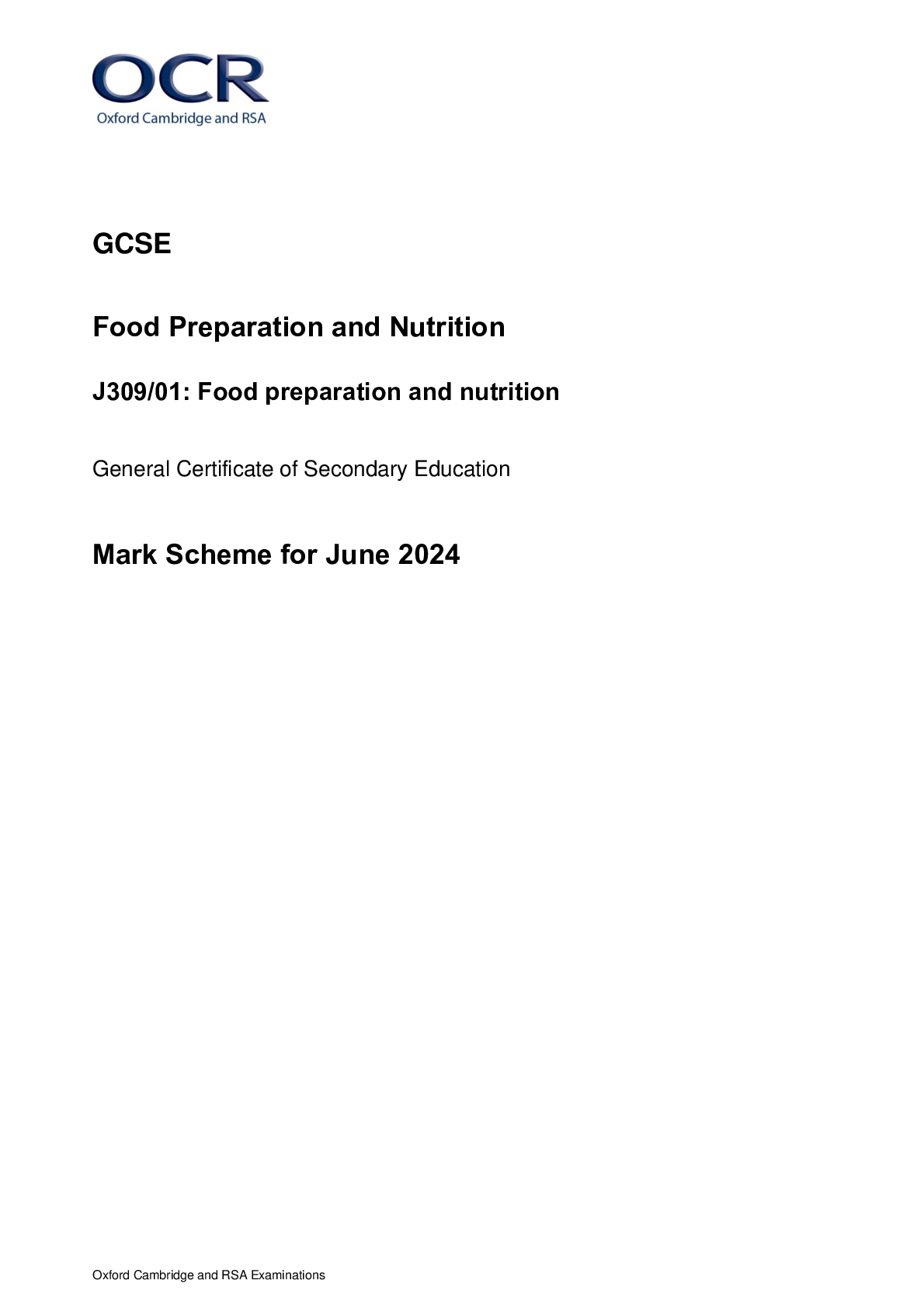
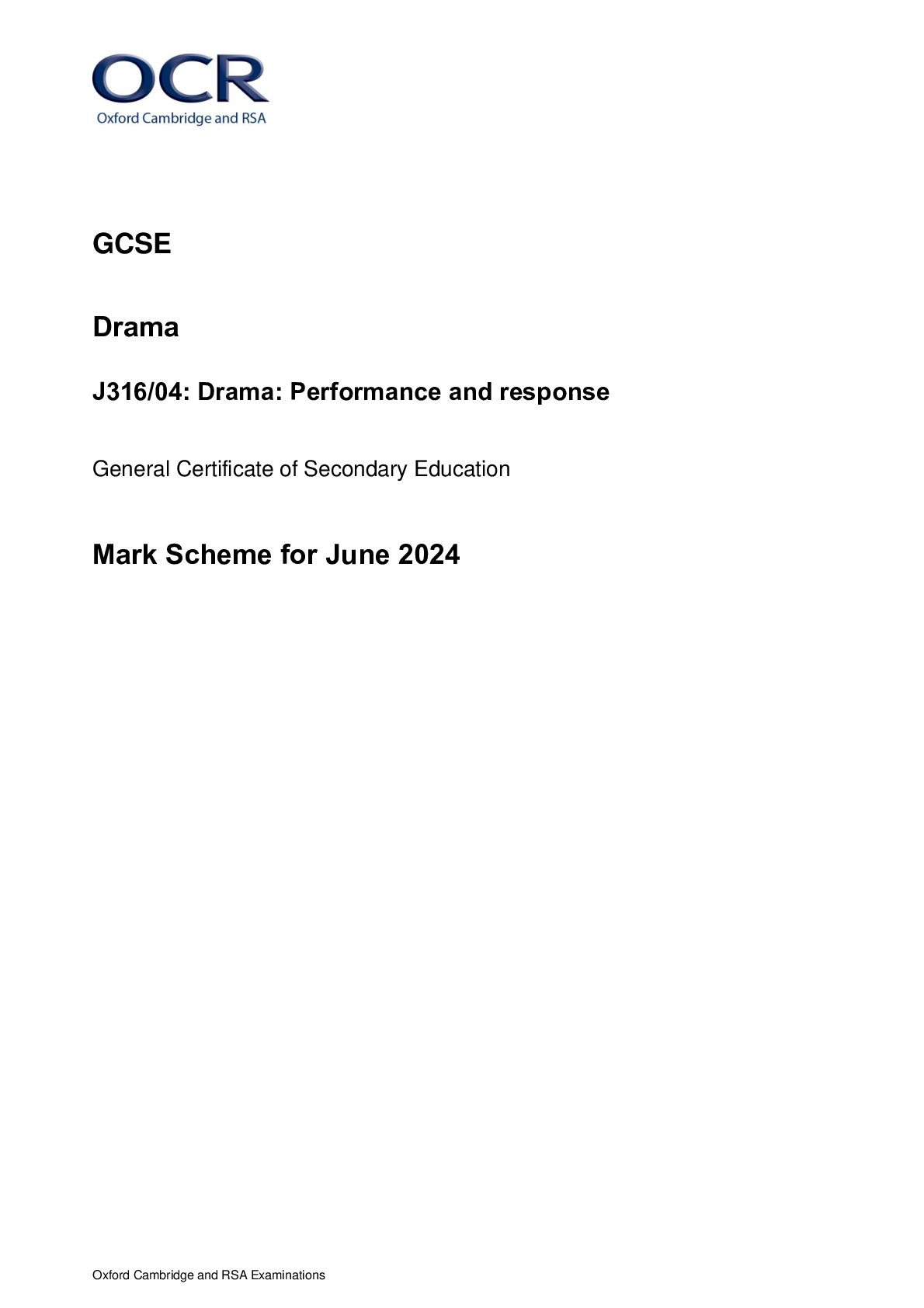
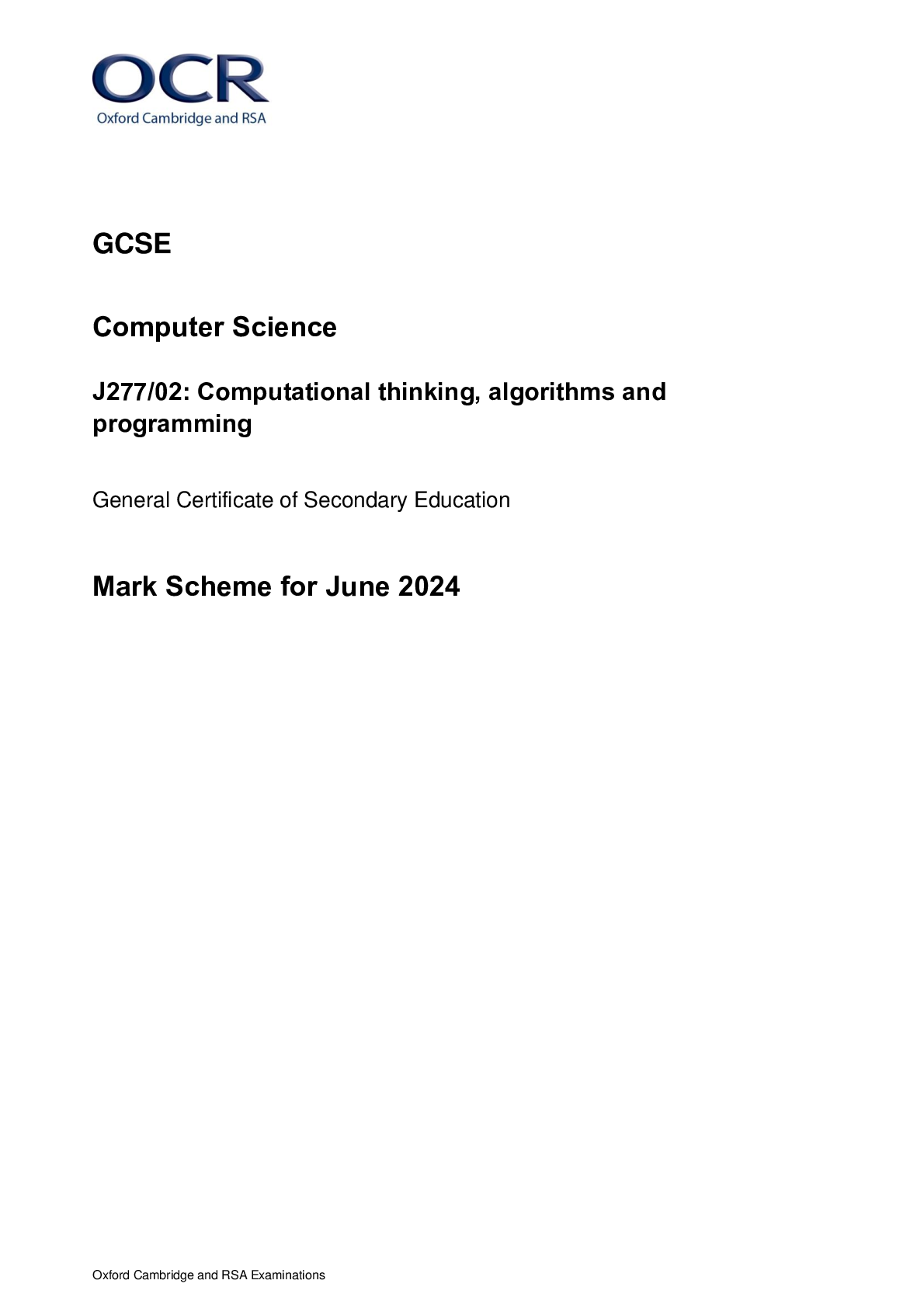
.png)

